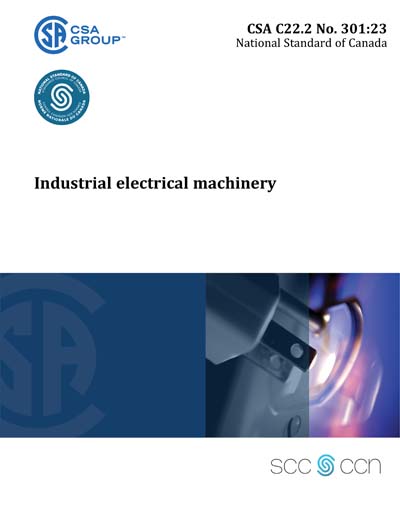Most recent
CSA C22.2 No. 301-2023
Industrial electrical machinery
Preface This is the second edition of CSA C22.2 No. 301, Industrial electrical machinery , one of a series of Standards issued by CSA Group under Part II of the Canadian Electrical Code. It supersedes the previous edition published in 2016. For general information on the Standards of the Canadian Electrical Code, Part II, see the Preface of CSA C22.2 No. 0, General Requirements — Canadian Electrical Code, Part II. The following are the major changes to this edition: a) expansion of Scope to include industrial robots and industrial robotics equipment; b) revisions and clarifications of existing requirements; c) introduction of new requirements for industrial robotics and industrial robotics equipment; d) introduction of new construction requirements related to temperature, enclosures, insulating materials, electrical spacings, and wet or outdoor locations; e) introduction of new electrical supply requirements, such as requirements for terminations, batteries, and battery circuits; f) revisions to equipment protection requirements and the introduction of surge protections applicable to industrial machineries; g) new bonding requirements for non-metallic enclosures; h) new marking requirements for wiring terminals; i) new type test requirements for battery overcharge test, breakdown components test, strain relief test, flexing test, and stability test; and j) introduction of Annex D, Additional requirements for industrial robots and industrial robotic equipment. This Standard is considered suitable for use for conformity assessment within the stated scope of the Standard. This Standard was prepared by the Subcommittee on Industrial Electrical Machinery, under the jurisdiction of the Technical Committee on Industrial Products, and the Strategic Steering Committee on Requirements for Electrical Safety, and has been formally approved by the Technical Committee. This Standard has been developed in compliance with Standards Council of Canada requirements for National Standards of Canada. It has been published as a National Standard of Canada by CSA Group. Scope 1.1 This Standard applies to industrial electrical machinery comprising interconnected mechanical, electrical, or electronic equipment, including industrial robots and industrial robotic equipment operating in a co-ordinated manner. Notes: 1) Examples of industrial electrical machinery covered by this Standard include handling and assembly machines, machines for packaging, factory automation machines, and inspection machines, as well as machine tools and machines for woodworking. 2) This equipment is sometimes referred to as a skid. 1.2 This Standard applies to equipment a) rated at not more than 1000 V ac or 1500 V dc; and b) intended to be installed and used in non-hazardous locations in accordance with the Canadian Electrical Code, Part I. 1.3 This Standard applies to equipment that is a) permanently installed; b) mobile; c) relocatable; or d) self-powered. 1.4 The equipment covered by this Standard is intended for use in an ambient temperature between 0 °C and 40 °C. 1.5 This Standard does not specify additional and special requirements for electrical equipment that a) is intended for use in open air (i.e., outside buildings or other protective structures); b) will use, process, or produce potentially explosive material (e.g., paint or sawdust); c) is intended for use in potentially explosive and/or flammable atmospheres; d) has special risks when producing or using certain materials; or e) is intended for use in mines. 1.6 This Standard does not apply to portable equipment connected by a cord and plug and operated by hand as covered by CSA C22.2 No. 71.1. 1.7 This Standard does not apply to self-propelled work platforms or on-road vehicular machineries. 1.8 This Standard does not apply to motor-operated appliances or equipment covered by CSA C22.2 No. 68 for household, commercial cord-connected, industrial cord-connected, rechargeable battery-operated, or permanently connected use. 1.9 This Standard does not specify additional and special requirements that can apply to electrical welding equipment within the scope of CSA C22.2 No. 60 or CSA/CAN-E60974-1. 1.10 This Standard may be used to supplement but does not replace requirements that already exist in a published CSA component standard. 1.11 In this Standard, "shall" is used to express a requirement, i.e., a provision that the user is obliged to satisfy in order to comply with the Standard; "should" is used to express a recommendation or that which is advised but not required; and "may" is used to express an option or that which is permissible within the limits of the Standard. Notes accompanying clauses do not include requirements or alternative requirements; the purpose of a note accompanying a clause is to separate from the text explanatory or informative material. Notes to tables and figures are considered part of the table or figure and may be written as requirements. Annexes are designated normative (mandatory) or informative (non-mandatory) to define their application.
Content Provider
CSA America, Inc. [csa]






